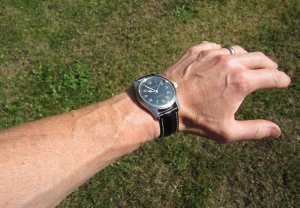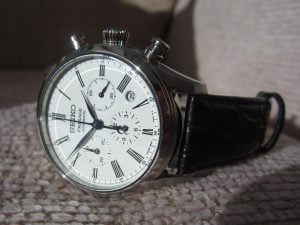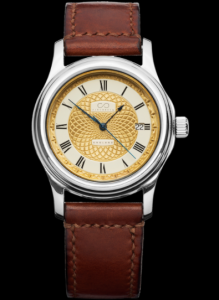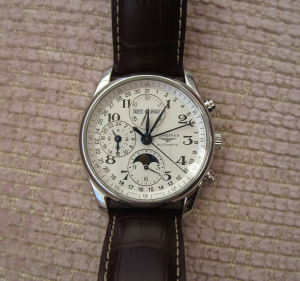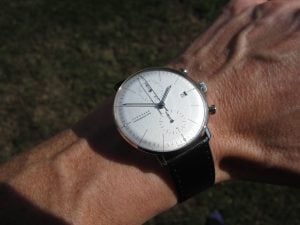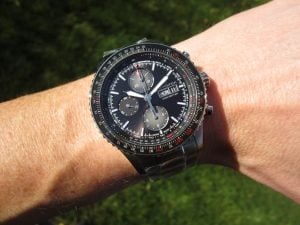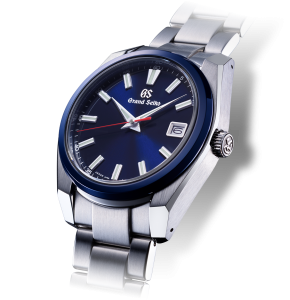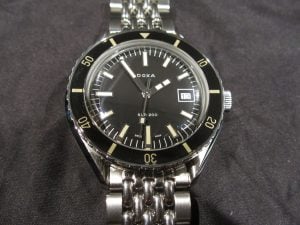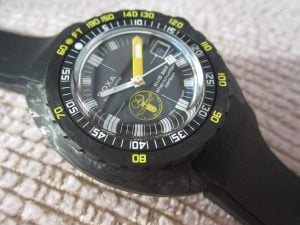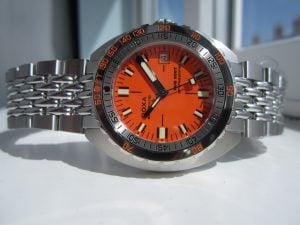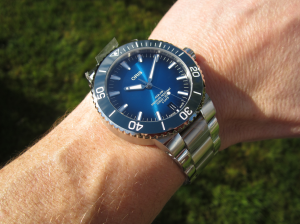Introduction.
The watch nerd fraternity, of which I am a fully paid up member, are a passionate bunch. Hypocritically, I’ve never understood the mind set of the car collector community whereby they insist on naming their cars. Even zealots may interpet this as misguided devotion. However, controversially, I do love it when a wrist watch gains its own fan given nomenclature. Seiko monopolise this particular fan trait with the Turtle, the Tuna Can, the Samurai, the Ripley, the Burke, the Bishop, the Pogue and the Arnie to name a few. Rolex should also get a special mention with the Paul Newman, the Pepsi, the Coke, the Kermit, the Batman, the Hulk and the Root Beer. Others include the Steve McQueen, the Ed White, the Ultraman (before an actual Ultraman was released), the Darth Vader and, lesser known, the Hamilton Kojak. As with a lot of these association related christenings by fan boys (and girls) the Hamilton Kojak became titled because it was worn by one of the coolest men on TV at the time: lollipop sucking, bubble gum popping, Buick driving, trilby wearing, hard as nails Detective Lieutenant Theo Kojak, played with ease by Telly Savalas from 1973 to 1978. In 1999 Theo Kojak was ranked 18th in America’s TV Guide list of Greatest TV Characters Of All Time (well, up to that point anyway). “Who loves ya’ baby?”.
As is common for me, this is a frustrating situation because an absolutely superb, historically important timepiece can lose some of this identity by being widely known as the watch that so-and-so wore as so-and-so on so-and-so. Hamilton have been victim to this before. The very first battery operated electronic wrist watch was the Ventura in 1957. This ground breaking technological marvel is now known as the Elvis or the Men In Black, for separate big screen appearances spanning nearly 50 years.
The Hamilton 500 movement was the first ever that was battery powered.

The King of Rock and Roll in his Hamilton Ventura.
And so is the case with the Hamilton Kojak, or it’s official designation “The Hamilton Q.E.D. (Quartz Electronic Digital) a derivative of the “The Hamilton Pulsar P2 2900”, which was the world’s first digital LED (Light Emitting Diode) and the basis for Hamilton’s new PSR. The QED was also the first LED watch to be distributed under the Hamilton name, instead of Pulsar. The Q.E.D. was an upgrade on the Pulsar P2 in that there were two pushbuttons, either side of the case. The right one toggled between time and seconds and the left one date and month. Development had also allowed for brighter LEDs and a more efficient circuitry.
Interestingly, the first big screen showing of the Hamilton Pulsar P2 2900 was on the wrist of James Bond in the opening scenes of Live and Let Die. This should be enough to place the watch in the silver screen icon bracket but, sadly, this showcase was overshadowed by the introduction of the high-intensity magnetic field and buzz saw wielding Rolex Submariner 5513 that Bond received in the very same scene. As can be clearly witnessed in the film, Bond has to press the time button twice because the display was only set to illuminate for 1.25 seconds.
History and Development.
Hamilton worked with a company called RCA to transpose the necessary technology into Integrated Circuits (ICs) using a new technological advancement, Complimentary Metal Oxide Semiconductors (CMOS). This is still widely used today. Fifty years of development means that we could now get 400 million of that very initial circuit onto the same real estate.
Hamilton met with Electro/Data, who they heard had been developing a digital wrist watch. A contract was signed in 1969, the very same year Hamilton was amalgamating with Breitling, Tag Heuer and Bruen to create the first ever automatic chronograph.
The first prototypes were delivered early in 1970, at which point the collaboration ended. The original advertising campaign for the first “digital wrist computer”, even though it only told the time, premiered in May 1970. Hence, the limited edition number of the latest example.
Many potential customers placed their $1500 order for the Time Computer which, Hamilton rightly campaigned, was the first new method of displaying the time in the last 800 years. Hamilton even got round the fact that the LEDs drained battery life at an extraordinary rate by having the time displayed upon the press of a button. Hamilton claimed this added tactility and involvement.
However, Hamilton’s PR department were slightly premature because, of the six prototypes delivered by Electro/Data, only one consistently worked. Hardly surprising given that the wrist watch had 2200 metal-to-metal connections, 13 ceramic circuit boards, 144 LEDs, 3 phototransistors and 44 ICs. It took a further three years to fulfil the reliability obligations and on March 23 1972 Hamilton placed an advert for the Pulsar Time Computer, so named because it was being manufactured by Pulsar, a division of the Hamilton Watch Company.
This was almost a concept prototype with only 400 pieces available, a solid 18ct gold case and a block of synthetic ruby for the crystal! The astronomical price of $2200 was the equivalent of about £10000 in today’s money! This was, therefore, the watch of a chosen few, including Jack Nicholson, Joe Frazier, Elton John and Keith Richards. However, by the end of the year all 400 pieces of the P1 were sold.
Costing a whopping $395 in 1973 when it was released, more than the Rolex Submariner 5513 mentioned above, the mass produced P2 was identical to the P1 but came in a stainless steel case. Due to this and the convoluted way of telling the time, the P2 never gained the market traction it deserved.
In 1979 the subsidiary Pulsar was sold to Seiko. Hence, the transposition of Pulsar to Hamilton on the latest model and the name change to PSR.
The Pulsar name can now be found on quartz analogue and LCD digital watches manufactured by Seiko. However, until the PSR re-edition there were no LED watches on the market.
Technology and Specification.
The brand new 2020 Hamilton PSR will be available in two versions. One all-steel model, reference H52414130, that will retail for £675 and a Limited Edition, of 1970 pieces, PVD gold plate version, reference 52424130, that will retail for £900. The Limited Edition version will come in a special commemorative box.
Both will have sapphire glass and 100 meter water resistance.
The case and bracelet have been sympathetically refined with exquisite satin finishing throughout. This truly is a high end timepiece in appearance and feel.
The LED display of the 1970s original is now created with up to date OLEDs alongside LCDs. The former acronym refers to Organic Light Emitting Diodes. To keep things simple, in what is a watch review, OLEDs emit light by passing electricity through incredibly thin layers of organic semiconductors, which is allowing TVs and display panels to become as economical and thin as possible, to the point where TVs can now be rolled up. The latter relates to Liquid Crystal Display which utilise the light-modulating properties of liquid crystals. These do not emit light directly but, instead, use a backlight to produce images, etc. So, now you know. What you really need to know, of course, is that this allows for a clear display of the time, etc, in even the brightest of light conditions, unlike the original, which was pretty difficult to read in daylight and impossible in direct sunlight.
A single button to the right of the case illuminates the time only display.
The original P1 and P2 were not only incredibly novel in the way that they displayed the time but also in how the time was set. A magnet was secreted within the clasp unit. This magnet was placed in specific areas on the caseback to set the minutes and the hour. Incredibly unique, and something I’ve never seen on any other watch. Unfortunately, at the time of writing there has been no communication from Hamilton about time setting protocols for the PSR. I will amend this article as soon as we have the new watches.
As mentioned above the original P2 displayed the time for just 1.25 seconds. There has been no mention on how long the PSR will remain lit. This will also be revised in due course.
Conclusion.
It’s hard to construct an unbiased review of the Hamilton PSR because I love the brand and the watch. At the point of its announcement I was watching a the rare few Hamilton QEDs that were available in the UK on a certain global auction website. I had promised myself one of these for a long time but was struggling to find one available in the UK, at the right price and with the Hamilton name and logo still visible on the dial. The problem being these were printed on the outside of the display and it is near impossible to find one that has not had these rubbed off over the last 45-50 years. It made more sense for me to try and chase one of these down because I am a massive Hamilton fan, rather than a Pulsar fan. I will now refocus to the triumphant re-imagining of the granddaddy of them all, the Hamilton PSR.
Nostalgia can be no stronger in a product than when there is absolutely no other example on the entire market. Like a lost craft by hand or human skill that’s no longer required in today’s world. The Hamilton PSR is the only new LED wrist watch available today. Yes, it is a massive indulgence, almost to the point of incongruence, to have a luxury wrist watch that does not present the time until prompted. However, it is this esoteric nature that appeals to me. This is an opportunity to celebrate a period in recent history where there were opportunities to be daring and push the boundaries, with no real motivation for doing so other than to be pioneering. It took the audacity and bravery of a brand like Hamilton to accomplish this. This contemplative wistfulness takes me back to when I was in Cubs, which must have been circa 1976. Myself and the other Cubs local to me were ferried via car by the parents, who took it in turns. I recall one of the other Cubs saying “Dad, make your watch do that thing”. I sat in awe and ached with jealousy as he pressed the button on, what it turned out to be, his Hamilton LED watch and made the time appear in actual numbers. I thought it to be a combination of trickery and witch craft. Don’t forget that this was before any sort of video game, TV reception was poor with only three channels available, mobile phones were carried around in rucksacks by the military, you researched your homework using encyclopaedias and music was bought in a shop on vinyl. Even in that state of complete wonder I couldn’t have envisaged how difficult it had been for Hamilton to conceive such a timepiece.
I have to say, the concept of limiting the gold plate example of the PSR bemuses me. A limited edition status for a watch can be contrived, as in this instance, but is usually due to lack of movements available, to commemorate a significant year, etc, or because it creates great PR for a specific family of timepieces. Due to reasons, that should be all too clear from my whimsical meanderings above, the gold example will find eager customers in very short order. The steel example is still historically significant and, I have to admit a little more practical, but I can’t see it selling like a non-limited gold version would. As with most Hamilton timepieces, the price point of the steel version is incredibly attractive. I can see true fans purchasing a steel version for day-to-day and a limited gold example for high days and holidays and, of course, watching Kojak on the TV. Because, let’s be honest here, that is what we do. Or, is it just me again? So, when the gold one is sold out it just leaves the steel version. As I said before, the steel version is gorgeous and exceptional value for money (Hamilton’s pricing never seems arbitrary) but there is going to be a big gap in Hamilton’s catalogue once the gold examples have all found homes.
I love the juxtaposition of having what is, let’s be honest, a novelty item, with the day-to-day/wear-it-anywhere specification of sapphire glass, surgical grade steel and 100m water resistance. It is the perfect recreational timepiece.
Overall though, I can find very little to fault with either of the new Hamilton PSRs. I have a collection of Hamilton watches because they are a brand with an impeccable history that creates covetable timepieces at justifiably affordable price points. The PSR epitomises this considerably. It is a wrist watch that celebrates a significant milestone in the history of, not just Hamilton but, the entire narrative of telling the time. There is a lot to luxuriate in, despite the fact that the PSR, effectively, breaks time down to its simplest form. The case and bracelet are beautifully finished and detailed to a standard that is beyond the price point. Hamilton’s original publicity script is still relevant nearly 50 years later because there is a tactile joy in pressing the button to reveal the time. In this day and age of constantly having to monitor the time the PSR would be the perfect antidote for this, to be worn during periods of relaxation whereby your luxury timepiece only ever divulges the time when it’s absolutely necessary. Finally, let’s not forget exclusivity. If you own one of these there will, likely, be no-one else who is telling the time using OLEDs.
Reading back some of my old reviews I am delighted to see that I try to be as balanced and unbiased in my appraisals. Usually, because of my passion for watches and watch collecting I conclude with “I love it” or “I want one”, etc, etc. However, I would like to close this particular diction with the ultimate accolade: I will be buying one of these when they are released in May……..or possibly two.
“Who loves ya’ baby?”…..I most definitely do.
All words by Richard Atkins. All images from Hamilton, unless otherwise stated. This article may not be reproduced in part or in whole without the permission of the author.

